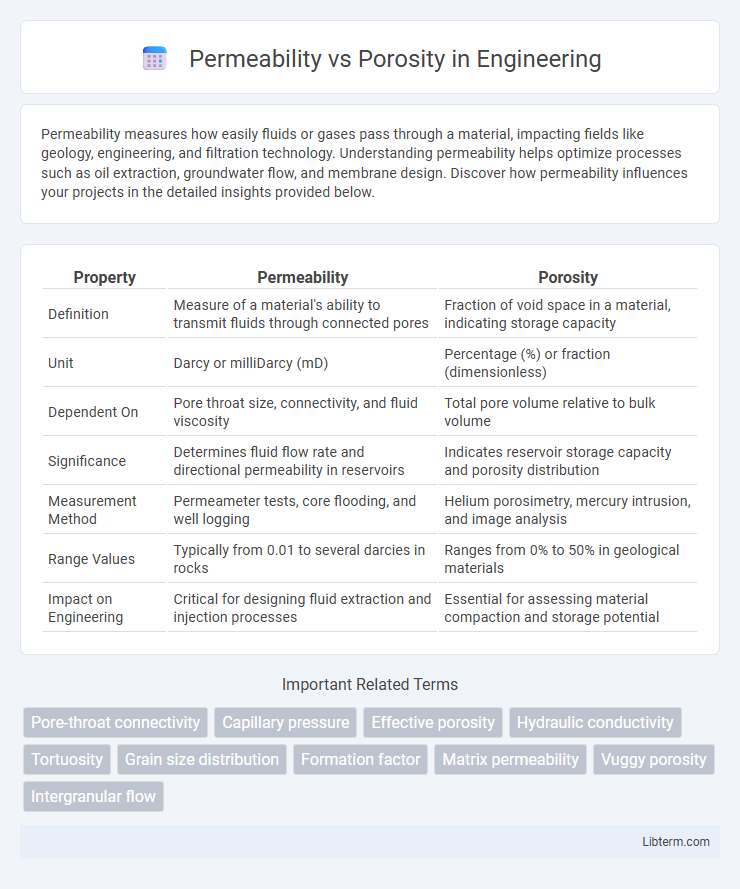Permeability measures how easily fluids or gases pass through a material, impacting fields like geology, engineering, and filtration technology. Understanding permeability helps optimize processes such as oil extraction, groundwater flow, and membrane design. Discover how permeability influences your projects in the detailed insights provided below.
Table of Comparison
| Property | Permeability | Porosity |
|---|---|---|
| Definition | Measure of a material's ability to transmit fluids through connected pores | Fraction of void space in a material, indicating storage capacity |
| Unit | Darcy or milliDarcy (mD) | Percentage (%) or fraction (dimensionless) |
| Dependent On | Pore throat size, connectivity, and fluid viscosity | Total pore volume relative to bulk volume |
| Significance | Determines fluid flow rate and directional permeability in reservoirs | Indicates reservoir storage capacity and porosity distribution |
| Measurement Method | Permeameter tests, core flooding, and well logging | Helium porosimetry, mercury intrusion, and image analysis |
| Range Values | Typically from 0.01 to several darcies in rocks | Ranges from 0% to 50% in geological materials |
| Impact on Engineering | Critical for designing fluid extraction and injection processes | Essential for assessing material compaction and storage potential |
Introduction to Permeability and Porosity
Porosity refers to the percentage of void spaces within a rock or sediment that can store fluids, while permeability measures the ability of those fluids to flow through the interconnected pores. High porosity does not necessarily imply high permeability, as fluid movement depends on the size, shape, and connectivity of the pore spaces. Understanding the relationship between permeability and porosity is essential in fields like hydrogeology, petroleum engineering, and soil science for effective reservoir characterization and fluid management.
Defining Porosity: What Does It Measure?
Porosity measures the percentage of void or empty spaces within a material, such as rock or soil, that can store fluids like water, oil, or gas. It quantifies the capacity of a reservoir to hold fluids but does not indicate how easily those fluids can flow through the material. Understanding porosity is essential for evaluating reservoir quality and estimating potential fluid volume.
Understanding Permeability: Key Concepts
Permeability measures a material's ability to transmit fluids through its interconnected pore spaces, directly influencing fluid flow rates in reservoirs and aquifers. Unlike porosity, which quantifies the total volume of voids within a rock or soil, permeability depends on the size, shape, and connectivity of these pores. High permeability is crucial for efficient extraction of hydrocarbons and groundwater, highlighting its importance in petroleum engineering and hydrogeology.
Types of Porosity in Materials
Types of porosity in materials include open porosity, closed porosity, and interconnected porosity, each significantly affecting permeability. Open porosity consists of voids connected to the surface, allowing fluid flow, while closed porosity contains isolated voids, restricting fluid movement. Interconnected porosity enhances permeability by providing continuous pathways for fluids through the material's pore network.
Factors Affecting Permeability
Permeability depends primarily on the size, shape, and connectivity of pore spaces within a material, which allows fluids to flow through. Factors affecting permeability include grain size distribution, degree of compaction, cementation, and the presence of fractures or faults. Materials with high porosity do not always exhibit high permeability, as poorly connected pores restrict fluid movement despite the available pore volume.
Relationship Between Porosity and Permeability
Porosity measures the volume of void spaces within a rock, while permeability quantifies how easily fluids flow through those interconnected pores. High porosity does not guarantee high permeability because if the pores are isolated or poorly connected, fluid flow is restricted despite significant void space. The relationship between porosity and permeability is often complex and depends on factors such as pore size distribution, pore connectivity, and the presence of fractures or micro-cracks.
Methods for Measuring Porosity and Permeability
Porosity measurement methods include mercury intrusion porosimetry, which evaluates pore volume and size distribution, and gas adsorption techniques like BET analysis that quantify surface area and pore structure. Permeability is commonly assessed using steady-state or transient flow techniques, such as constant head or falling head permeameter tests, which measure fluid flow rates under controlled pressure gradients. Advanced non-destructive imaging methods like micro-CT scanning provide detailed 3D visualization of pore networks, simultaneously enhancing porosity and permeability characterization.
Importance in Geology and Engineering
Porosity measures the volume of void spaces in a rock, while permeability indicates the ability of fluids to flow through those spaces, both critical for evaluating reservoir potential in geology and engineering. High porosity does not guarantee high permeability, influencing decisions in hydrocarbon extraction, groundwater management, and civil engineering projects. Accurate assessment of both properties ensures efficient resource recovery and infrastructure stability.
Real-World Applications and Case Studies
Permeability measures the ability of a material to transmit fluids, while porosity indicates the volume percentage of void spaces within a rock or soil. In petroleum engineering, high permeability and porosity in reservoir rocks enhance hydrocarbon recovery, as demonstrated by the North Sea oil fields where sandstone formations with permeability exceeding 100 millidarcies and porosity above 15% enable efficient extraction. Groundwater studies in the Ogallala Aquifer further highlight that despite high porosity, low permeability zones can restrict water flow, impacting sustainable water management strategies.
Conclusion: Comparing Permeability and Porosity
Permeability measures a material's ability to transmit fluids, while porosity quantifies the volume of void spaces within it. High porosity does not always indicate high permeability, as pore connectivity and size significantly influence fluid flow. Effective reservoir evaluation requires integrating both properties to accurately assess fluid movement potential.
Permeability Infographic

 libterm.com
libterm.com